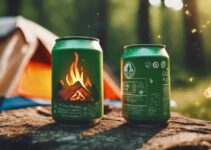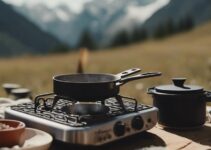Is there really a definitive answer when it comes to choosing between canned heat and traditional campfires for camping? As someone who's spent a considerable amount of time nestled in the great outdoors, I've seen arguments made for both sides. Each has its unique set of advantages, whether it's the convenience and safety of canned heat or the unmatched ambiance and warmth of a real campfire. But before you make up your mind, consider the environmental impact, ease of use, cooking efficiency, and not to mention, the cost implications of both options. There's more to this debate than meets the eye, and understanding the nuances could greatly enhance your camping experience.
Key Takeaways
- Canned heat offers immediate ignition and precise cooking but incurs a consistent cost.
- Traditional campfires provide a natural experience but require skill for effective heat management.
- Both options have environmental impacts, from resource consumption to carbon emissions.
- Safety considerations favor canned heat in fire-prone areas, whereas campfires demand careful management to prevent wildfires.
Instafire Canned Heat Overview
While exploring the domain of portable heating solutions for camping, it's crucial to consider Instafire Canned Heat, which offers a unique blend of convenience and efficiency. Analyzing the fuel types, Instafire utilizes a proprietary blend, guaranteeing a clean burn with minimal smoke, a significant advantage over traditional wood or liquid fuels. This aspect alone positions it as a more environmentally friendly option, reducing the carbon footprint associated with camping. Additionally, the storage convenience of Instafire Canned Heat cannot be overstated. Its compact design allows for easy packing without the worry of spills or leaks, a common concern with liquid fuels. This feature ensures that space efficiency and safety are prioritized, making it an ideal choice for campers seeking hassle-free heating solutions.
Traditional Campfire Basics
Moving from the ease of canned heat, I'll now shift my focus to the intricacies of setting up a traditional campfire. Building a campfire requires not only an understanding of the materials and structure needed for ignition but also a thorough approach to safety precautions to mitigate risks. It's important to analyze both these aspects to guarantee an enjoyable and secure camping experience.
Building a Campfire
Building a traditional campfire requires understanding its structure, materials, and the sequential steps necessary for safe and efficient ignition. Wood selection is paramount; choosing the right type of wood can determine the fire's longevity and intensity. Hardwoods, like oak or maple, are preferable for a long-burning fire, while softer woods like pine are ideal for kindling. Additionally, the use of fire starters can greatly ease the ignition process. These can range from store-bought options to natural alternatives like dry leaves or small twigs.
To construct a campfire effectively, consider:
- *Gathering a mix of tinder, kindling, and fuel wood.*
- *Arranging the materials in a stable structure, such as a teepee or log cabin layout.*
- *Using fire starters strategically for a quicker and safer ignition.*
Safety Precautions
Guaranteeing the safety of oneself and the surrounding environment is always paramount when lighting a traditional campfire. Analyzing the dynamics of campfire safety, it's clear that wildlife interaction and emergency preparedness stand out as critical areas of focus. Wildlife can be attracted or harmed by campfires, while emergencies require swift, informed responses.
| Aspect | Why It Matters |
|---|---|
| Wildlife Interaction | Prevents attracting or harming animals, maintaining ecosystem balance. |
| Emergency Preparedness | Ensures quick, effective reactions to fire outbreaks or accidents. |
These components underscore the importance of being mindful and prepared. By minimizing wildlife interaction, we protect local fauna and reduce risks of dangerous encounters. Emergency preparedness, on the other hand, empowers us to handle unforeseen incidents effectively, safeguarding both ourselves and the natural habitat we enjoy during our camping adventures.
Ease of Use Comparison
Turning our attention to the ease of use comparison between canned heat and campfires, it's important to contemplate both the setup time and the skill level required. I've found that the simplicity or complexity of preparing each heat source greatly influences the overall camping experience. Analyzing these aspects will help in determining the most user-friendly option for various camping scenarios.
Setup Time
When comparing the setup times of canned heat sources versus traditional campfires, it's evident that the former offers a more straightforward and quicker initiation process. This is primarily due to several factors that directly impact the efficiency of starting a fire:
- Weather conditions: Canned heat is less susceptible to adverse weather, making it reliable in situations where setting up a campfire would be challenging.
- Space requirements: Canned heat necessitates minimal space and can be used in areas where open fires are not permissible.
- Immediate use: Unlike campfires, canned heat can be ignited instantly without the need for gathering wood or preparing a fire pit.
These points highlight the practicality of canned heat, especially when quick setup and ease of use are prioritized.
Skill Level Required
Analyzing the skill level required for utilizing canned heat compared to setting up a traditional campfire reveals a significant disparity in ease of use. Using canned heat is straightforward; it merely involves opening the can and lighting it, making it less dependent on weather conditions or the availability of specific equipment. On the other hand, creating a campfire demands more intricate knowledge, from selecting the right kind of wood and kindling to understanding airflow and fire management. This process is heavily influenced by weather conditions; damp wood or windy conditions can thwart efforts. Additionally, the equipment availability, such as a lighter or matches and possibly a hatchet for wood, plays a significant role. Essentially, canned heat offers a simpler, more reliable option for those lacking extensive outdoor skills or facing unpredictable weather.
Environmental Impact
One important factor in choosing between canned heat and campfires for camping is their respective environmental impacts. I've taken a thorough look into both options, aiming to understand how they affect the natural world around us, especially when we're trying to enjoy it through camping.
- Wildlife disruption: Campfires can alter the behavior of local wildlife, potentially causing stress or harm due to the smoke and large flames.
- Carbon footprint: The production and disposal of canned heat contribute to carbon emissions, albeit often less than the carbon released by burning wood in a campfire.
- Natural resource consumption: Campfires consume wood, a natural resource, which can lead to deforestation and habitat destruction if not sourced sustainably.
Analyzing these points, it's clear that both options have their environmental drawbacks, requiring careful consideration.
Safety Considerations
Delving into the domain of safety considerations, I've found that both canned heat and campfires present unique risks that demand careful evaluation. When considering fire bans, it's clear that canned heat often gets the green light in areas where traditional campfires are prohibited due to wildfire risk. This aspect alone can greatly sway a camper's choice, particularly during dry, fire-prone seasons. On the other hand, campfires, if allowed, need to be managed with extreme caution to prevent unintended wildfires. Moreover, the attraction of wildlife is a critical safety concern. Campfires might draw curious animals closer to the campsite, potentially leading to dangerous encounters. Canned heat, being less conspicuous, tends to be less of an attractant, offering a safer alternative in this regard.
Cooking Efficiency
Having considered the safety aspects of both canned heat and campfires, it's now necessary to evaluate their cooking efficiency to further inform a camper's choice. Cooking efficiency can greatly impact the camping experience, influencing not just the quality of meals but also the effort and resources needed for preparation.
- Fuel availability: Canned heat offers a consistent fuel source, ensuring that heat is available whenever needed, unlike campfires which depend on the availability of dry wood.
- Temperature control: Canned heat provides a more controlled and steady heat source, allowing for precise cooking temperatures. This is often challenging with campfires, where the heat can fluctuate and is harder to regulate.
- Ease of use: Setting up canned heat for cooking is generally quicker and requires less expertise than building and maintaining a campfire, making it a more efficient option for those unfamiliar with outdoor cooking techniques.
Cost Analysis
While considering the cost implications of canned heat versus campfires for camping, it's important to analyze not only the initial purchase price but also the long-term expenses associated with each cooking method. Canned heat, being a manufactured product, requires a consistent financial outlay for replenishment. Its price can fluctuate based on fuel availability and market trends. On the other hand, campfires primarily rely on natural resources, which can be freely available or obtained at a minimal cost. However, the accessibility of firewood is subject to seasonal restrictions and regional regulations, potentially incurring costs if one needs to purchase it. Areas prone to wildfires might impose fines for campfire usage, an indirect cost worth considering. While campfires might seem cost-effective initially, external factors like fuel availability and seasonal restrictions can influence the overall expense.
Frequently Asked Questions
How Do Weather Conditions Affect the Choice Between Canned Heat and Campfires for Outdoor Cooking?
I've found that weather forecasting is vital for outdoor cooking choices. Wet conditions favor canned heat, avoiding fire hazards. Dry, calm weather leans towards campfires, aligning with my clothing choices for warmth and safety.
Can Canned Heat Be Used Inside Tents or Camping Vehicles for Heating Purposes?
I'd say using canned heat inside tents or vehicles requires strict safety precautions due to limited ventilation. It's more fuel-efficient than campfires, but the risk of carbon monoxide poisoning must be carefully considered.
What Are the Regulations and Legal Considerations for Using Canned Heat Versus Campfires in National Parks and Wilderness Areas?
When considering the use of canned heat versus campfires, it's important to understand fire bans and permit requirements in national parks. Each has specific regulations that can greatly impact one's camping experience and safety.
How Do the Scents and Ambiance Created by Canned Heat Compare to Those of Traditional Campfires?
Diving into sensory experiences, campfires weave a tapestry of woodsy aromas, unmatched by canned heat. Analytically, campfires offer a richer ambiance but at a greater environmental impact, highlighting a balance between sensory delight and ecological mindfulness.
Are There Any Innovative or Alternative Camping Heat Sources That Challenge the Dominance of Canned Heat and Campfires in the Market?
I've found that solar cookers and biofuel stoves are emerging challengers to canned heat and campfires. They're not only eco-friendly but also efficient in diverse camping conditions, offering a sustainable alternative with less environmental impact.





